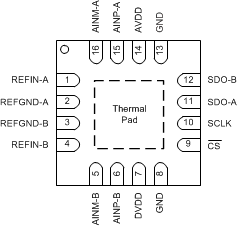SBAS580D May 2013 – March 2018 ADS7250 , ADS7850 , ADS8350
PRODUCTION DATA.
- 1 Features
- 2 Applications
- 3 Description
- 4 Revision History
- 5 Pin Configuration and Functions
-
6 Specifications
- 6.1 Absolute Maximum Ratings
- 6.2 ESD Ratings
- 6.3 Recommended Operating Conditions
- 6.4 Thermal Information
- 6.5 Electrical Characteristics: All Devices
- 6.6 Electrical Characteristics: ADS7250
- 6.7 Electrical Characteristics: ADS7850
- 6.8 Electrical Characteristics: ADS8350
- 6.9 Timing Requirements
- 6.10 Switching Characteristics
- 6.11 Typical Characteristics: ADS7250
- 6.12 Typical Characteristics: ADS7850
- 6.13 Typical Characteristics: ADS8350
- 6.14 Typical Characteristics: All Devices
- 7 Detailed Description
- 8 Application and Implementation
- 9 Power Supply Recommendations
- 10Layout
- 11Device and Documentation Support
- 12Mechanical, Packaging, and Orderable Information
Package Options
Mechanical Data (Package|Pins)
- RTE|16
Thermal pad, mechanical data (Package|Pins)
- RTE|16
Orderable Information
5 Pin Configuration and Functions
RTE Package
16-Pin WQFN
Top View

Pin Functions
| PIN | I/O | DESCRIPTION | |
|---|---|---|---|
| NAME | NO. | ||
| AINM-A | 16 | Analog input | Negative analog input, ADC_A |
| AINM-B | 5 | Analog input | Negative analog input, ADC_B |
| AINP-A | 15 | Analog input | Positive analog input, ADC_A |
| AINP-B | 6 | Analog input | Positive analog input, ADC_B |
| AVDD | 14 | Supply | ADC supply voltage |
| CS | 9 | Digital input | Chip-select signal; active low |
| DVDD | 7 | Supply | Digital I/O supply |
| GND | 8, 13 | Supply | Device ground |
| REFGND-A | 2 | Supply | Reference ground potential, ADC_A |
| REFGND-B | 3 | Supply | Reference ground potential, ADC_B |
| REFIN-A | 1 | Analog input | Reference voltage input, ADC_A |
| REFIN-B | 4 | Analog input | Reference voltage input, ADC_B |
| SCLK | 10 | Digital input | Serial communication clock |
| SDO-A | 11 | Digital output | Data output for serial communication, ADC_A |
| SDO-B | 12 | Digital output | Data output for serial communication, ADC_B |
| Thermal pad | Supply | Exposed thermal pad. TI recommends connecting the thermal pad to the printed circuit board (PCB) ground. | |